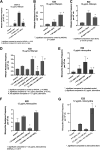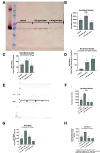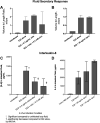Role of the SOS Response in the Generation of Antibiotic Resistance In Vivo
- PMID: 33875437
- PMCID: PMC8373240
- DOI: 10.1128/AAC.00013-21
Role of the SOS Response in the Generation of Antibiotic Resistance In Vivo
Abstract
The SOS response to DNA damage is a conserved stress response in Gram-negative and Gram-positive bacteria. Although this pathway has been studied for years, its relevance is still not familiar to many working in the fields of clinical antibiotic resistance and stewardship. Under some conditions, the SOS response favors DNA repair and preserves the genetic integrity of the organism. On the other hand, the SOS response also includes induction of error-prone DNA polymerases, which can increase the rate of mutation, called the mutator phenotype or "hypermutation." As a result, mutations can occur in genes conferring antibiotic resistance, increasing the acquisition of resistance to antibiotics. Almost all of the work on the SOS response has been on bacteria exposed to stressors in vitro. In this study, we sought to quantitate the effects of SOS-inducing drugs in vivo, in comparison with the same drugs in vitro. We used a rabbit model of intestinal infection with enteropathogenic Escherichia coli strain E22. SOS-inducing drugs triggered the mutator phenotype response in vivo as well as in vitro. Exposure of E. coli strain E22 to ciprofloxacin or zidovudine, both of which induce the SOS response in vitro, resulted in increased antibiotic resistance to 3 antibiotics: rifampin, minocycline, and fosfomycin. Zinc was able to inhibit the SOS-induced emergence of antibiotic resistance in vivo, as previously observed in vitro. Our findings may have relevance in reducing the emergence of resistance to new antimicrobial drugs.
Keywords: RecA; enteropathogenic E. coli; fosfomycin; heteroresistance; hypermutation; minocycline; rabbit model; rifampin; zidovudine; zinc.
Figures






Similar articles
-
Zinc blocks SOS-induced antibiotic resistance via inhibition of RecA in Escherichia coli.PLoS One. 2017 May 22;12(5):e0178303. doi: 10.1371/journal.pone.0178303. eCollection 2017. PLoS One. 2017. PMID: 28542496 Free PMC article.
-
Zinc Blockade of SOS Response Inhibits Horizontal Transfer of Antibiotic Resistance Genes in Enteric Bacteria.Front Cell Infect Microbiol. 2018 Nov 21;8:410. doi: 10.3389/fcimb.2018.00410. eCollection 2018. Front Cell Infect Microbiol. 2018. PMID: 30519543 Free PMC article.
-
Inhibition of SOS Response by Nitric Oxide Donors in Escherichia coli Blocks Toxin Production and Hypermutation.Front Cell Infect Microbiol. 2021 Dec 22;11:798136. doi: 10.3389/fcimb.2021.798136. eCollection 2021. Front Cell Infect Microbiol. 2021. PMID: 35004358 Free PMC article.
-
The central role of the SOS DNA repair system in antibiotics resistance: A new target for a new infectious treatment strategy.Life Sci. 2020 Dec 1;262:118562. doi: 10.1016/j.lfs.2020.118562. Epub 2020 Oct 8. Life Sci. 2020. PMID: 33038378 Review.
-
Bacterial hypermutation: clinical implications.J Med Microbiol. 2011 May;60(Pt 5):563-573. doi: 10.1099/jmm.0.024083-0. Epub 2011 Feb 24. J Med Microbiol. 2011. PMID: 21349992 Review.
Cited by
-
Role of Extracellular DNA in Bacterial Response to SOS-Inducing Drugs.Antibiotics (Basel). 2023 Mar 24;12(4):649. doi: 10.3390/antibiotics12040649. Antibiotics (Basel). 2023. PMID: 37107011 Free PMC article.
-
Exploring the Impact of Chemotherapy on the Emergence of Antibiotic Resistance in the Gut Microbiota of Colorectal Cancer Patients.Antibiotics (Basel). 2025 Mar 5;14(3):264. doi: 10.3390/antibiotics14030264. Antibiotics (Basel). 2025. PMID: 40149075 Free PMC article. Review.
-
Enterotoxin tilimycin from gut-resident Klebsiella promotes mutational evolution and antibiotic resistance in mice.Nat Microbiol. 2022 Nov;7(11):1834-1848. doi: 10.1038/s41564-022-01260-3. Epub 2022 Oct 26. Nat Microbiol. 2022. PMID: 36289400 Free PMC article.
-
Combined inactivation of the SOS response with TCA fumarases and the adaptive response enhances antibiotic susceptibility against Escherichia coli.Front Microbiol. 2025 May 9;16:1570764. doi: 10.3389/fmicb.2025.1570764. eCollection 2025. Front Microbiol. 2025. PMID: 40415939 Free PMC article.
-
RecA-dependent or independent recombination of plasmid DNA generates a conflict with the host EcoKI immunity by launching restriction alleviation.Nucleic Acids Res. 2024 May 22;52(9):5195-5208. doi: 10.1093/nar/gkae243. Nucleic Acids Res. 2024. PMID: 38567730 Free PMC article.
References
Publication types
MeSH terms
Substances
Grants and funding
LinkOut - more resources
Full Text Sources
Other Literature Sources
Research Materials

